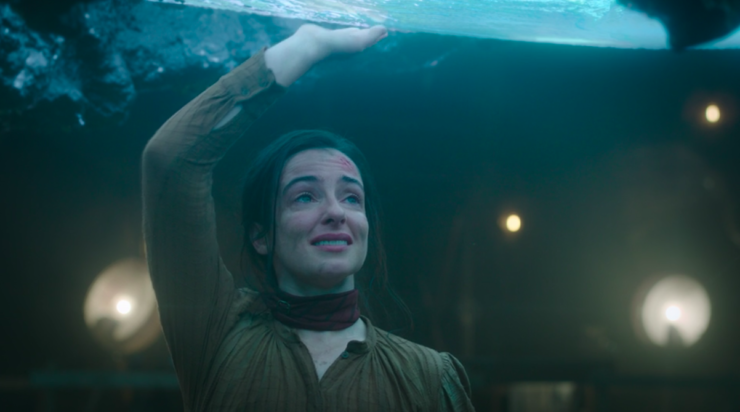Over a decade ago, Joss Whedon’s Dollhouse incredibly recontextualized its first season with “Epitaph One,” a dystopian flash-forward revealing a glimpse of the bleak future that came about from uploading new personalities into pliant Dolls. It was a wonderfully ambitious narrative risk that paid off even in the short-lived series. But now history is repeating itself in The Nevers, the latest Whedonverse offering that was already struggling to set up its own magic trick, grasping for a prestige worthy of its characters’ supernatural turns. Instead, the Part One finale “True” recycles Dollhouse’s trick, radically changing the series’ premise in a way that distracts from, rather than amplifies, the Touched.
Major spoilers for The Nevers season One.
So… I guess I was right? It was aliens.
“True” jumps ahead several centuries to basically the end of the world: a sci-fi warfront in which humanity has, true to form, ignored the offerings from an alien race called the Galanthi. Yep, one and the same as the blue orb being excavated beneath London, except that these Galanthi are dinosaur-looking creatures from another dimension. The worldbuilding is as rapid-fire as the laser guns, but it would appear that at some point there were about twenty Galanthi on Earth, releasing “spores” that would make certain people more empathetic to what the Galanthi were trying to pass on, even as the planet’s land, water, and atmosphere grew increasingly toxic.
At this indeterminate point, there is one Galanthi left, with humans having split into two contentious factions—the Planetary Defense Coalition (PDC), which doesn’t love the Galanthi but recognizes that they need them for survival, and Free Life, who would rather torture the Galanthi until they eventually force the aliens to retreat into some portal and leave humanity on its own.
Into this dilemma comes a PDC crew, almost all of whom will die by the end of the episode’s first chapter, face-to-face with the last remaining Galanthi. Among the humans, the important figures are two PDC soldiers, who in that society’s fashion have adopted nicknames instead of intimately revealing their true names, and a Free Life spy, who freely shares his name and guns down half the team in order to get to the Galanthi before it opens a portal to bring in what they think are reinforcements.
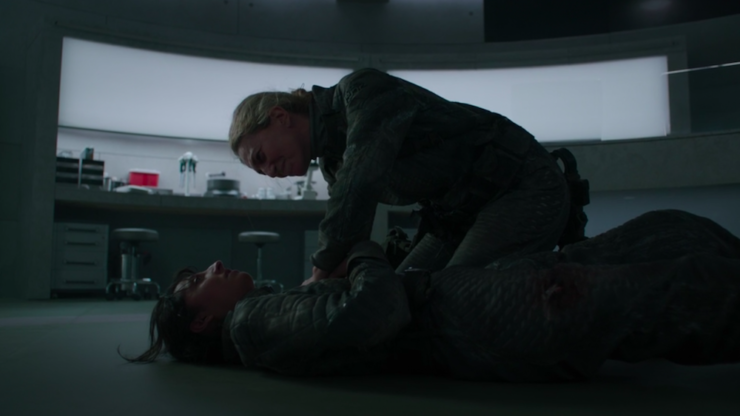
But first we should mention that one of the PDC soldiers, embittered Stripe, is Claudia. Freaking. Black. Aeryn Sun herself shows up as The Nevers’ coolest secret casting, embodying humanity’s utter loss of hope after refusing the gifts and engagement of the Galanthi. When the Free Lifer murders everyone, including sweet Knitter (who has what we’ve come to know as a turn, even if that turn is just hoping for a better world), Stripe doesn’t avenge her; she lies to her as she dies, then drinks poison to join her in oblivion. Turns out the Galanthi wasn’t bringing more friends, it’s escaping these awful people, and she can’t blame it.
Up to this point, Black entirely sells this rock-bottom despair and regret for another timeline in which humanity might have trusted in help and saved themselves. But then out come those signature bright-blue tendrils, which somehow collect her entire consciousness/soul/what-have-you and carry it into the portal—which was headed not to another dimension, but to 1896. That is, the day the Touched first received their mysterious gifts.
The Galanthi’s ship (which is what it must be) scatters spores onto everyone, as we saw in the pilot, and deposits Stripe’s soul into the body of the widow Amalia True, having just jumped into the Thames. So it’s not that Amalia was bestowed with foresight, but rather that an entirely other self who happened to already have foresight took over her body and has been inhabiting it for the entire series thus far.
Here’s the problem: This makes The Nevers an entirely different show.
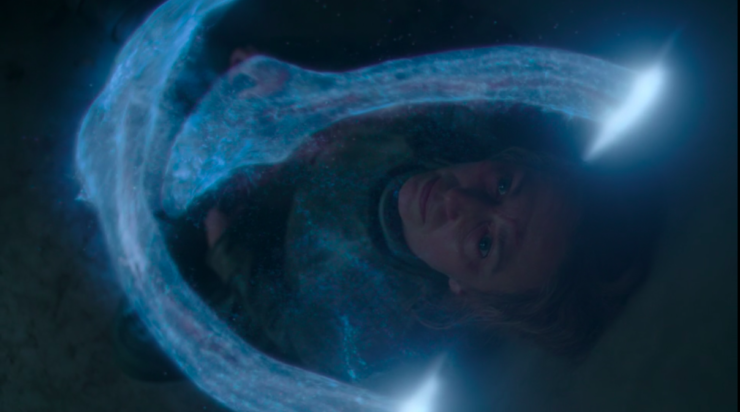
“Epitaph One” and later “Epitaph Two” jumped far enough in its series’ future—about ten years—that viewers’ delight was in seeing how drastically each of Dollhouse’s main characters had changed, made almost unrecognizable from their last time on-screen: Caroline imprinted in a child’s body, Sierra and Victor on opposite sides of the self-augmentation debate, Topher gone mad. Even its new characters were merely a bridge toward understanding what happened to the Dollhouse and its beloved season one cast.
As the episode’s second chapter explores, poor Molly experienced what unfortunately seems like a pretty period-appropriate bleak lifespan: Despite being gifted with baking talent, the only future available to her—not a dream in her head—was to marry, and not the cute penniless suitor who dreams of giving her a tea house in which to serve her financiers. Instead, within a few short years she’s the widow True (a blessing, considering how breathtakingly cruel her butcher husband is about her two miscarriages), stuck taking care of her stubbornly alive mother-in-law and branded as a barren portent of misfortune. It’s no surprise that, after sending some financiers to her could-have-been husband and his new family, Molly channels Stripe’s desolation and turns toward the Thames.
Revealing that Stripe has been True this whole time, rather than developing the enigmatic character from naïve Molly into hardened Amalia, is a narrative cop-out. Which is not to say that Black—and then Donnelly-as-Black—don’t act the hell out of a hopeless-soldier-turned-Victorian-superhero. But it transforms The Nevers from a series about women and other underprivileged people suddenly granted the kinds of powers that could reverse the power balance in a historical era into a time travel adventure where some random Victorian-era population must change the timeline itself lest their far-off descendants destroy the planet. Instead of being a show about a closed-minded society fighting modernity, they’re literally fighting the future…?
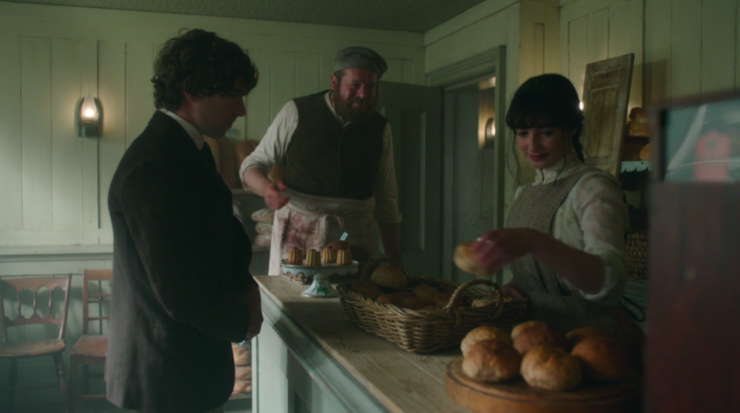
It would have been so much more interesting for the Molly we had met to grapple with this second chance: brought back from suicide, burdened with an unwelcome gift and a mission that nonetheless will take her further than even the butteriest financier ever could. And while it’s funny to watch a soldier from Canada learn how to go undercover as a proper Englishwoman, enough to earn the interest of Lavinia Bidlow, we haven’t seen enough of Amalia being anachronistic to truly appreciate Stripe’s presence in retrospect in the past five episodes. At least now I get the subtext behind the “you look very nice”/”I think so” banter and her telling the Beggar King that “this isn’t my face.”
Further, there’s very little narrative friction to Stripe’s adjustment in this time period: She and Dr. Cousens begin their affair while she’s at the insane asylum, mostly because she sees a vision of that happening, during which time she activates his turn. We also learn that at some point she clued Penance in to her mission from the future, which the Touched inventor seems to take in stride with very little concern for the dual-suicide-leading-to-single-reincarnation. The only conflict for Stripe-as-True is her giving up fellow Touched asylum patient Sarah to Dr. Edmund Hague for his experiments that would eventually turn that poor sweet girl into the serial killer Maladie. With her knowledge of exactly what the turns are, it made little sense that Stripe would just give up a potential ally—one who’s already talking about their mission, for crissakes!
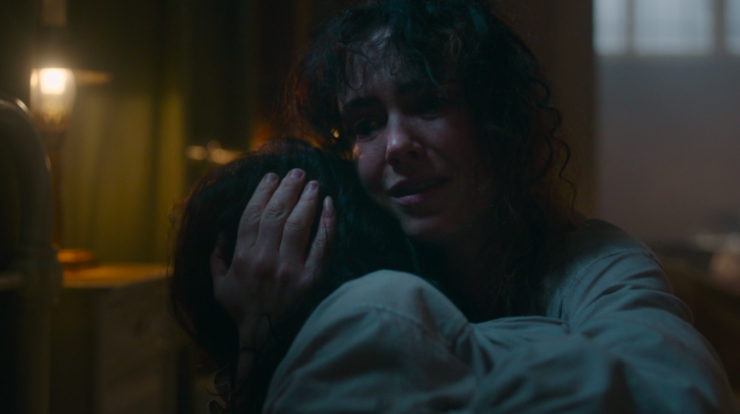
With all that context to (re)establish, “True” thankfully still builds in enough time to explore just what had Amalia’s team looking so bloody and dazed at the end of the fifth episode, “Hanged.” Or, at least, to tease Stripe’s mission for Part Two. Upon encountering the Galanthi face-to-orb, Stripe demands to know what it wants her to do, and instead gets a bevy of future-glimpses in Lord Massen trying to kill her (not surprising) and in Myrtle, dressed somewhat futuristically and speaking English.
“Did you think you were the only one who hitched a ride?” she asks, and then tells Amalia that this moment is so far ahead that she’s going to need her to forget it for the moment. But we won’t…!

Honestly, Maladie’s Effie reveal last week, despite being a direct homage to The Usual Suspects, was more fun than this convoluted recontextualization. Devoting so much of the episode to catching up on Stripe’s adjustment to Victoriana means that we only move a few steps ahead in the present, which doesn’t make it feel like a finale. At the point that Amalia and Penance have decided to clue in the rest of the orphans as to their true mission, Maladie is still skipping through the streets! By the time Amalia tells everything we’ve just seen, Maladie will have returned to the underworld to plot her next move. So much has changed, but also very little progress seems to have been made.
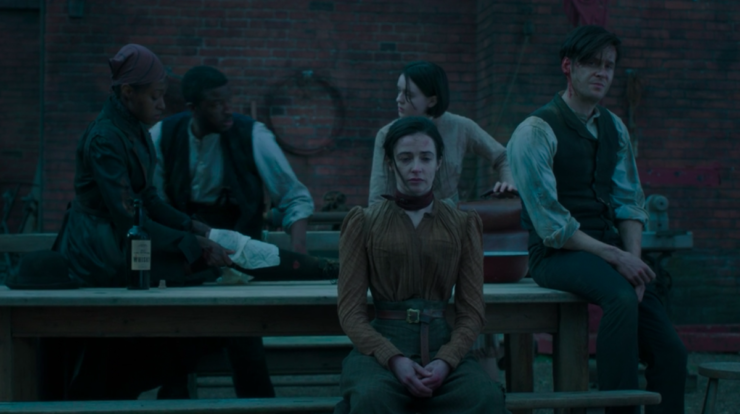
Tricks and Turns
- So Mary got the “I am a leaf on the wind” treatment, and Myrtle is back to being the stealth power-waif. Cool cool cool. The big question is, who hitched a ride inside her? Of the folks we met in the first chapter, the only likely candidate is the Free Life guy, but an old guy inhabiting a young girl’s body seems especially creepy.
- For all of the titillation at the start, the Ferryman’s Club has been waning in importance the last few episodes. Hugo Swann didn’t even show up in this episode, and Augie only came in for a brief bird assist that nonetheless seems to have allied him with the Touched (rather than as the reluctant financier behind the Club). It’s unclear if the Touched that Swann employs will clash more with Amalia’s orphans or with the council of lords.
- Ditto Mundi—I really thought he and Amalia would have more of a Phryne Fisher/Jack Robinson relationship, even if platonic, but all of his charged scenes are with his sorta-ex Hugo. Mundi also clearly wants to be Touched as an explanation for his queerness, and/or his sadness, but so far he seems to be stuck chasing after Maladie, as he’s the only person who currently knows she’s still alive.
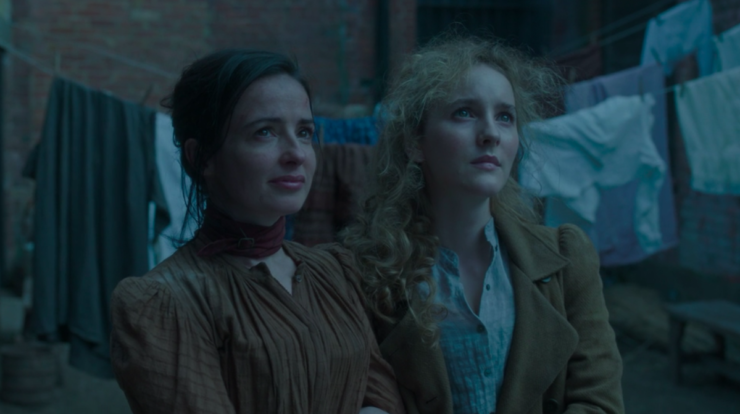
- There must be “flashbacks” to the future planned with Stripe—you don’t bring on Claudia Black for twenty minutes and then never use her again.
- I know that Stripe revealing her real name to Penance was supposed to be a beautiful moment signifying the depth of their friendship and trust, but the delivery of “my name is Zephyr Alexis Navine” came off as so overwrought that I couldn’t help giggling.
- Presumably Whedon’s influence extended to structuring the Part One finale and this big plot game-changer. It’s unclear how much he might have plotted out Part Two with the writers’ room before departing from the series, but new showrunner Philippa Goslett has quite the narrative deck to work with. I just don’t know if there’s enough here to make sense of for a satisfying first-season finale.
What did you think of The Nevers Part One finale? What do you want to see in Part Two?
Natalie Zutter would love to know how the Galanthi’s interference led to a reluctance to share names. Ponder The Nevers Part 2 with her on Twitter!










